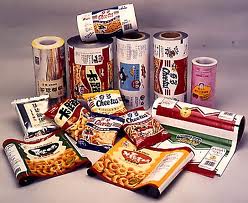FOOD PACKAGING TECHNOLOGY
Introduction
In the recent era, package of a product is one of the most important things determining the success of marketing, especially in food industry. Food packaging has some purposes, such as to make light of transportation and storage of the product, to be the identity of the product, to interest consumer, to increase the price, to protect the product from damage, or to extend the shelf-life of the product. This paper shows several methods of food packaging to extend the shelf-life of food, during transportation or storage. It is important to be noted that not all of the packaging methods mentioned in this paper.
Aseptic Packaging
Aseptic packaging is a type of packaging method that has to satisfy at least four pre-requirements such as that the product must be sterile, the package must be sterile, the environment of filling process must be sterile, and the package must be dense in order to inhibit re-contamination during storage. This packaging method is applied for various product such as milk and juice, especially liquid product that has low acidity. The principle of aseptic packaging is applied to both food and package which must be free from microorganism during filling process so the product could result in a sterilized product. It means that pathogenic microorganism cannot grow or produce toxin. If the condition is applied, the product will be safe to be storaged in room temperature in longer time.
Edible Film
Edible film is a type of food package that can be eaten. Edible film can be made of some properties such as hydrocoloid, fat, and plastisizer (lauric acid, lactic acid, triethylen glycol, or polyethylen glycol). The package is a thin layer coating a food, and it can obstruct mass transfer from the food such as humidity, oxygen, and fat. Edible film must have the same characteristic as plastic, meaning that it can hold water content in the product. Edible film also must have selective permeability for some certain gasses, restrain transfer of soluble solid, keep color and pigment of product, and keep nutrient of product. Using edible film for package food product such as sausage, fruit, and vegetable can decelerate quality decline of the food because it can function as restraint diffusion of oxygen, carbon dioxide, fume, and also flavor agent. The advantage of this package based on previous explanation is extending shelf-life of food. Besides, edible film does not contaminate our environment because edible it can be eaten with the food packaged.
Vacuum Packaging
Vacuum packaging is a type of packaging method that describes the practice of removing air from the package. The aim of the work is to take out oxygen, since oxygen can oxidize the food. It results in chemical damage and quality decrease. Material used for vacuum packaging is plastic wrap or freezer paper due to its ability to obstruct oxygen and air entering the package. This packaging method is used to wrap various food e.g snack and grainy product. As the machine, vacuum sealer is used for this work.
Vacuum sealer works as mentioned. Plastic contained food is entered to the machine horizontally. The open-ended plastic is put on the heat sealer and the machine works automatically since it is closed. Initially, air is blown to the package, then all of the air is removed, so the pressure inner is lower than outer. After that, heat sealer works to gum the plastic.
Modified Atmosphere Packaging (MAP)
Modified Atmosphere Packaging (MAP) is a type of package that describes the practice of modifying the composition of air in the package. This method is for improving the shelf-life of the product. The modification process is to lower the amount of oxygen, to decrease it from 20% to 0%, in order to slow down the growth of aerobic lifeforms and the speed of oxidation reactions. The removed oxygen can be replaced with nitrogen (inert gasses) or carbon dioxide, which can lower the pH or inhibit the growth of bacteria.
In MAP, the air surrounding the food in the package is changed to another composition. MAP is used with various types of products like meat, fish, fruits and vegetables, where the mixture of gases in the package depends on the type of product, packaging materials and storage temperature. Meat and fish need very low gas permeability films, so high barrier films are used. But fruits and vegetables are respiring products where the interaction of the packaging material with the product is important. If the permeability of the packaging film is adapted to the products respiration, an equilibrium modified atmosphere will establish in the package and the shelf-life of the product will increase.
Conclusion
In the recent era, packaging method is developed for some purposes such as making light of transportation and storage of the product, being the identity of the product, interesting consumer, increasing the price, protecting the product from damage, or improving the shelf-life of the product. Aseptic packaging, edible film, vacuum packaging, and MAP are examples of packaging method to improve shelf-life of the product. They work for specific food with their own system. Nowadays, the package methods mentioned is used by some food industry in Indonesia.
